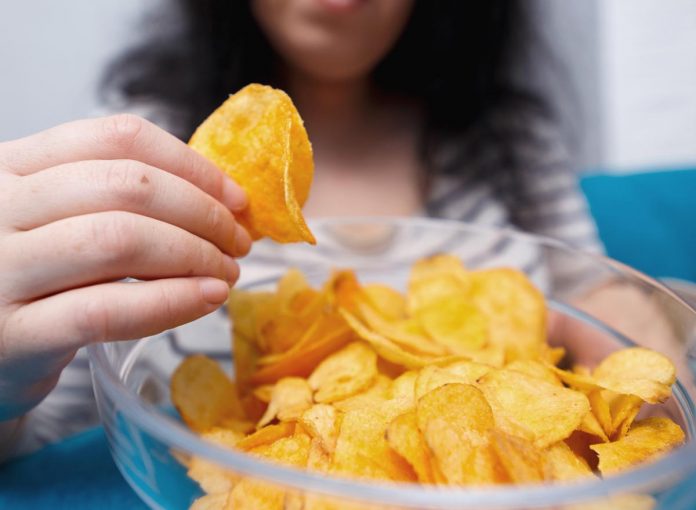The chip aisle is wonderfully colorful and crowded these days, with potato chips cuddling right up next to their newer counterparts: veggie chips made from roots and tubers. These bags containing a crispy rainbow of thinly sliced sweet potatoes, beets, parsnips, and the like seem to have earned a permanent place next to their conventional cousins. (Unlike, say, kale or green bean chips, which are a whole ‘nother sector of the alterna-chip economy we’re not even going to get into here.) You might have grabbed them over the bag of regular ol’ potato chips they sit next to, maybe because you think they’re tastier or you feel like being fancy.
But if you’ve been tempted to forsake your beloved potato chips (and shell out a premium, btw) in the name of your health, we need to talk. Because the fact is, veggie chips are no more or less healthy than regular potato chips .
Quick question: Why do people even eat veggie chips?
Potatoes in just about any form are undeniably delicious, but they kind of have an image problem. “Culturally, we’ve all been taught that potatoes in all forms, including potato chips, are unhealthy and ‘fattening,’ per se,” Colleen Tewksbury, Ph.D., M.P.H., R.D., senior research investigator and bariatric program manager at Penn Medicine and president-elect of the Pennsylvania Academy of Nutrition and Dietetics, tells SELF.
The potato chip in particular is often attacked in a way that feels a little personal. Diet culture has done a fine job of positioning potato chips as a junk food or guilty pleasure. Once maligned for being too fatty during the low-fat craze; these days, at the height of the low-carb diet trend the starchy root vegetables are just too carb-y. Classic chips are also on the hit list of processed food-naysayers. These innocent little crisps can’t catch a break.
Enter: the veggie chip, strategically marketed as a more natural, more wholesome, more nutritious chip. “People perceive them as being healthy: Oh, they’re vegetables!” Beth Kitchin, Ph.D., R.D.N., assistant professor in the UAB Department of Nutrition Sciences, tells SELF. And I get it, veggie chips seem like the perfect answer to someone who’s looking for a salty, crunchy snack but has been told that potato chips are bad for you.
“I think a lot of their appeal is playing into individuals’ desire to have a yummy snack with a healthy angle they can feel better about,” Tewksbury explains. Veggie chips are basically viewed as a way to incorporate more vegetables in your diet while still eating chips, producing a subtle but powerful “health halo” effect, Cara Harbstreet, M.S., R.D., L.D., of Street Smart Nutrition, tells SELF.
The thing is “foods that carry the health halo don’t necessarily translate into foods that are nutritionally superior,” Harbstreet says, “as is the case with veggie chips versus regular potato chips.”
Get ready for some nutrition label truth-bombs.
Let’s set curious tuber branding conventions aside and turn the bag over to compare what’s actually inside them nutrition-wise.
Classic potato chips, including Lay’s and Ruffles, typically contain just three ingredients: potatoes, some kind of vegetable oil (sunflower, corn, and/or canola oil), and salt. (That’s for the plain ones; flavored varieties also contain other ingredients, like food coloring, sugar, cheese, and any number of seasonings and flavorings.)
The ingredient labels for other veggie chips are nearly identical; just swap out the vegetable. For instance, Terra chips—which contain a rotating variety of seasonal root veggies, like sweet potatoes, taro, parsnips, and cassava—have a similarly simple recipe: vegetables, beet juice (for coloring), vegetable oil (canola, safflower, or sunflower), and salt.
The nutrition facts also look strikingly similar. “Depending on the brand you’re looking at, they usually have comparable fat, calorie, carb, and fiber content,” Tewksbury says. The nutritional profile for a 1-ounce serving of Classic Lay’s (about 15 chips) and a 1-ounce serving of Original Ruffles (about 12 chips) are the same: Both contain 160 calories, 15 grams carbs, 1 gram fiber, 2 grams protein, 10 grams fat, and 1.5 grams saturated fat.
Meanwhile, a 1-ounce serving of the original Terra chips blend contains 150 calories, 16 gram carbs, 3 gram fiber, 1 gram protein, 9 gram fat, and 1 gram saturated fat. So these contain ever so slightly fewer calories, protein, and fat, as well as marginally more carbs and fiber. (Other options, like sweet potato or beet chips, will contain a bit more naturally-occurring sugar.) So this particular brand and variety does offer two additional grams of fiber, which isn’t nothing but also isn’t huge. And as Harbstreet points out, “since the majority of fiber in the U.S. diet comes from whole grains, it ends up being a negligible difference in most cases.”
“But I’m eating vegetables!” you exclaim, while clutching your bags of veggie chips at Whole Foods. Correction: You are eating chips made of various root vegetables. Know what else is a root vegetable that makes a delicious chip? A potato.
“There really aren’t any meaningful nutritional benefits to veggie chips in particular over potato chips,” Tewksbury says. Both are at the end of the day just root vegetables that have been thinly sliced, fried, and salted for your snacking pleasure. Or as Kitchin puts it, “potato chips aren’t as bad for you as you think they are, and veggie chips aren’t as good for you as you think they are.”
Now, it is true that “you’re getting slightly different sets of vitamins and minerals because you’re eating different tubers,” Tewksbury says. And it is generally great to mix up your veggie intake. But the small differences between different varieties of tubers aren’t enough to make an impact, Tewksbury explains, especially since they’re a snack and not a major component of your diet anyway.
And I don’t know who needs to hear this, but veggie chips probably shouldn’t be your main source of vegetables. Yes, they’re mostly made of vegetables. But en route from fresh veggie to crispy chip, vegetables lose nearly all of their water content and gain a good amount of oil. This renders a pretty calorically dense snack that serving per serving probably won’t provide quite the same satisfaction or nutritional quality as, say, a baked sweet potato or raw beet salad. “They don’t really fill you up a ton because they’re not heavy,” Kitchin says. “And that also makes it easier to eat a lot of them mindlessly.”
So from an R.D.’s perspective, the most legit potential downside of veggie chips is not what you’re getting from them, but what else you could be missing if they’re not an addition to other vegetables but a substitute for them, Tewksbury says.






























